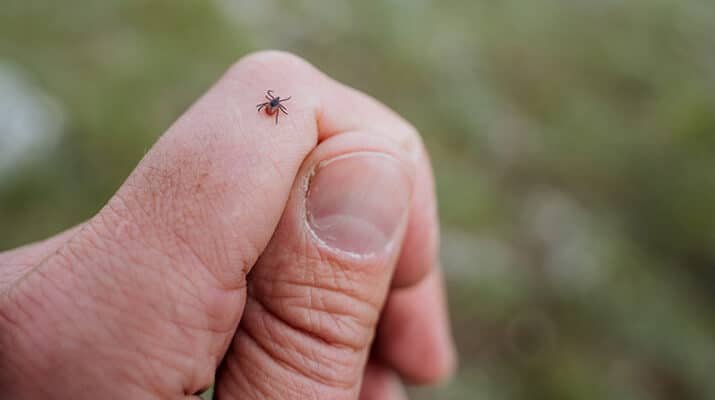Protect yourself and your family from Lyme disease
By Deborah Jeanne Sergeant

Deer ticks, also known as black legged ticks, can carry and transmit the bacteria that cause Lyme disease.
The illness was named for Lyme, Connecticut, where it was first identified in the US.
Unless tick bite patients infected with Lyme are treated early with antibiotics, the disease causes patients to experience swollen knees, paralysis, skin rashes, headaches and severe chronic fatigue.
Late-term use of antibiotics is not always as effective.
Not every tick transmits Lyme disease. Still, avoiding deer tick bites can prevent infection. Once the weather reaches above 40 degrees F., ticks can emerge. The New York State Department of Health states that deer ticks are most active from April through mid-May and also in early fall.
“The most effective way to prevent tick-borne diseases is by minimizing exposure to ticks,” said Saravanan Thangamani, SUNY Empire Innovation professor of microbiology and immunology at Upstate Medical University. “To lessen contact with ticks, steer clear of wooded areas and dense brush, especially where tall grass and leaf litter are present. While hiking, stick to marked trails and walk centrally to reduce the likelihood of encountering ticks.”
Thangamani directs the SUNY Center for Environmental Health and Medicine and the Vector Biology Laboratories at Upstate. He is an expert in vector-borne diseases, specifically tick-borne and mosquito-borne diseases including those caused by pathogens such as the Lyme disease agent. The Upstate Tick Testing Laboratory (www.nyticks.org) also tests ticks.
“Before engaging in outdoor activities, apply insect repellent,” he said. “Treat your outdoor clothing and camping gear, including socks and shoes, with a 0.5% permethrin solution for long-lasting protection through several washes.”
Although it should not be applied directly to the skin but on clothing, backpacks and footwear, permethrin can help deter ticks. Keep permethrin away from cats. While it is wet, it’s highly toxic to cats.
“Additionally, tumble dry your clothes in a high-heat dryer for at least 10 minutes to eliminate ticks,” Thangamani said. “After coming home, shower promptly and perform a thorough tick inspection on your body and pets.”
It takes ticks 24 hours to crawl to where they typically like hiding. Since they’re so tiny and don’t typically tickle as they move, it’s easy to miss ticks on the body.
“Pay special attention to areas like underarms, behind the ears, around the hairline, inside the belly button and between legs, as these are common places where ticks may attach,” said Kassandra Foley, regional director of Infection Prevention at St. Joseph’s Health and St. Peter’s Health Partners.
Another tick preventive is providing dogs with monthly prescription parasite medication such as drops or a Simparica Trio pill, which guards against ticks, fleas and heartworm.
“Even with collars and medication, double check them,” said Stephanie E. Waldron, director of environmental health assessment for Onondaga County. “On the bellies a lot of times you could see ticks. Animals seem to bring them indoors quite a bit. Use flea and tick control medication from your vet.”
Check the animal’s fur, especially between the toes and behind the ears, for ticks after time spent outdoors.
Although people tend to think of picking up ticks while hiking off-trail, the encroachment of wild animals near homes can mean simply gardening can expose homeowners to ticks. Foley said that maintaining the landscaping can help reduce this risk. Mow the lawn and trimmed bushes present an area less attractive to wildlife and a lower likelihood that ticks will be present since they prefer to wait on tall grasses for hosts to walk by. Keep wildlife away from the home by minimizing attractants like food, water and shelter. Leaving out pet food and water bowls invites wildlife to help themselves and bring along ticks. Block off any cracks where critters can crawl into outbuildings.
“Ticks thrive in areas with high grass and dense vegetation, so creating a buffer between wooded areas and places where you and your pets spend time can help reduce the risk,” Foley said. “Consider creating areas of your yard that are less tick-friendly by using gravel, wood chips or cedar chips to create borders around gardens, play areas and patios. These act as barriers to ticks that typically do not like to cross hard, dry surfaces.”
Ticks can hide in moist organic debris such as leaf litter. Remove these regularly.
“Consider treating your yard with acaricides — pesticides designed to kill ticks — before the season starts,” Foley said. “There are both chemical and natural options available. Check with local garden centers or pest control companies for guidance on safe and effective treatments.”
Read the labels to make sure they’re safe for your pets.
Fortunately, Lyme disease is treatable, but prompt treatment is more effective. Foley said that Lyme disease presents with fever, fatigue, headache and a bull’s-eye rash.
“If you find a tick attached to your skin, remove it properly with fine-tipped tweezers, gripping as close to the skin as possible and clean the area with antiseptic,” Foley added. “If you develop any symptoms, contact your healthcare provider immediately for evaluation and potential testing.”
So, What Spray Can Keep Ticks Away?
Diane Oldenburg, associate public health educator with Oswego County Health Department, recommends:
“EPA-registered insect repellents and always read the labels,” she said. “If you are using sunscreen, apply sunscreen first then insect repellent second.”
• products with DEET
• picaridin
• IR3535
• oil of lemon eucalyptus (OLE)
• para-menthane-diol (PMD)
• 2-undecanone
In addition, consider “light colored clothing, long sleeves, socks and closed toe shoes and pants tucked into socks,” she said.

